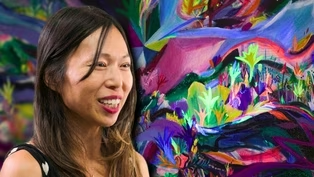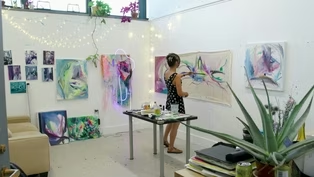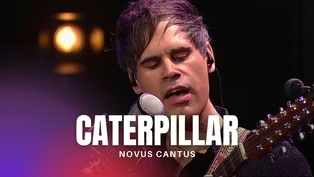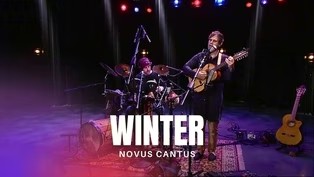
Albany Rock Project Aims to Make Art Accessible to BIPOC Communities
Clip: Season 10 Episode 2 | 8m 53sVideo has Closed Captions
Discover how The Albany Rock Project uses painted rocks to inspire and engage Albany's youth.
The Albany Rock Project, founded by Coach Bree Hassell, is a unique initiative aimed at engaging Albany's youth through the creative use of hand-painted rocks. Bree, a former educator, turned to art during the pandemic to address the lack of play opportunities for children. The project focuses on making art accessible, particularly in BIPOC communities.
Problems playing video? | Closed Captioning Feedback
Problems playing video? | Closed Captioning Feedback
AHA! A House for Arts is a local public television program presented by WMHT
Support provided by the New York State Council on the Arts (NYSCA), M&T Bank, the Leo Cox Beach Philanthropic Foundation, and is also provided by contributors to the WMHT Venture...

Albany Rock Project Aims to Make Art Accessible to BIPOC Communities
Clip: Season 10 Episode 2 | 8m 53sVideo has Closed Captions
The Albany Rock Project, founded by Coach Bree Hassell, is a unique initiative aimed at engaging Albany's youth through the creative use of hand-painted rocks. Bree, a former educator, turned to art during the pandemic to address the lack of play opportunities for children. The project focuses on making art accessible, particularly in BIPOC communities.
Problems playing video? | Closed Captioning Feedback
How to Watch AHA! A House for Arts
AHA! A House for Arts is available to stream on pbs.org and the free PBS App, available on iPhone, Apple TV, Android TV, Android smartphones, Amazon Fire TV, Amazon Fire Tablet, Roku, Samsung Smart TV, and Vizio.
Providing Support for PBS.org
Learn Moreabout PBS online sponsorshipI was an educator before I was an artist, before I was officially an artist entrepreneur I am today.
And the pandemic happens, and I lost my job at that time.
And that meant that I was an educator of 850 students to zero because of the pandemic shut down.
And I became very concerned about solving, solving the problem of students not being able to play enough.
This was in the time of basketball hoops being, the rims being pulled off of the backboard.
This is the time of the netting of the basketball hoops being tied together as an institutional response of you can't play here.
And that was the first time in my life I'd ever seen something like that.
And because of that, I wanted to create something that was accessible, colorful, and fun.
- That's beautiful.
- Yes.
- The Albany Rock Project.
- The Albany Rock Project was born October of 2020.
- So give us a little bit of background.
What is the project?
- In short, I say that I paint rocks, and I hide them throughout the city.
I start the rock drops in black and brown neighborhoods, but the location of these rocks change all the time.
And so in short, I wanted to be able to serve BIPOC communities and to also be able to give them opportunity to play more.
An opportunity to just take a pause and enjoy the moment.
- Yeah, now why rocks?
- Again, back to the accessibility part.
Everybody knows what a rock is, right?
We could walk outside right now and understand what a rock is.
And I think I wanted to use something that didn't have to be explained too much as a medium.
And I think rocks already are underestimated.
So I think it's helpful to make some, to use something like that and to beautify it and to help people re-understand what beauty could be.
- That is true.
And you're like, it's from nature, can come in and beautify, you know your community by your own work.
- Yes, really travel friendly too.
- That is true, good point.
- And so like you could, the rock, the rock that you see here won't be there again because it's been transported somewhere else and is leaving an impact somewhere else.
- Now, quick question.
- [Bree] Sure.
- Have you ever, have you ever painted like a boulder?
- I want to, but nobody will let me yet.
And so I don't know if that's because it's a boulder or if it's because, you know, we just need a little bit more planning around how to transport this big entity.
- Yeah, not as accessible with that one.
- Right.
- Yeah, so I know you invite a lot of artists into this project.
- Yes.
- So what are some like unique opportunities that artists that you hire, what do they gain?
What do they get?
What does that look like?
- That's so interesting.
Thank you for asking that.
For me, I wanted to include artists in the local community a little bit more in the Albany Rock Project by providing an opportunity for them to develop themselves artistically.
What does that mean and what does that look like?
I offer them opportunity to paint a rock collection, and that's usually eight to 12 rocks of different sizes and different textures.
And I challenge them to use this medium to express their motifs, their artistic style and things of that nature.
Typically, I also pay them for their time, for any time that we meet.
And I also pay them for the work that's implemented.
What do they gain from this?
I think they gain career readiness.
I think they increase their artistic skill with these rocks 'cause they're not perfectly smooth either.
And I think that they increase their ability to advocate for themselves.
- Sounds like the full package, you're getting funding, you're getting like workforce developmency.
- Workforce development yeah.
- And life enrichment all in one package, right?
- Yeah, I've had artists come back to me after I've asked for some feedback around how I could make it better.
And I've had artists say, honestly, it was just a great time.
I haven't had the opportunity to just sit and to enjoy something that I'm creating in a while.
And so I like to offer that to them too.
- That's a beautiful thing.
- So as someone, like let's pretend, never, you're talking to someone, they've never been, never heard of the Albany Rock Project.
They're walking into your program or they're walking to an event.
- [Bree] Yes.
- What does it look like for a first time person stepping into this project?
Like what would they expect?
- Well, they would expect to have some warmth when they come in, to receive warmth from me specifically.
I love to laugh.
I'm very open.
You could see, you could already feel it on me.
Like I just love to have a good time, and I love to build community.
And what does it mean to build community?
It means to be inviting so that people can come and make that choice for themselves.
And so warm, welcoming.
I also, I like to be flexible.
There are a lot of people who are very uncomfortable with art, and because of that they just walk away before they even try.
And so I like to use all of those things together to create the space for people to become more vulnerable with themselves to do the art.
- Yeah.
- I know you know that people immediately say, oh, I'm not good at art or art's, not my thing.
Insert whatever, what other things people tell themselves.
But I like to create the environment so people can put that down.
- Yeah, so it's just like, this is a free creative space.
You can start as simple as you want.
- [Bree] Yes.
- Or as complicated as you want.
- [Bree] Right.
- And you should feel safe doing whatever, - Whatever that is exactly.
- Because it's about expression and community at the end of the day, right?
- Right.
- That's awesome.
So what are some, do you have any like community stories or any impact you've seen?
Like how are folks reacting to this?
'Cause this has been going on for a little bit.
- [Bree] Yeah!
- So like how has been the feedback or the community reactions?
I know you work with kids all the way up to the adults, so.
- Yeah, it's a wide range of ages that I cover.
And I think I like it that way.
I don't think it's just a kid thing.
I think adults also can be transformed by this work too.
I've seen it on a micro level.
I have gone out and hidden the rocks myself because that's what has to be done in order for people to go find them, they have to be hidden.
And I was being followed by a group of six children who noticed that I was hiding.
- The rocks.
- The rocks, and I became so, I became so caught up in the fact that I was being followed that I missed out On what they were experiencing.
- Yeah.
- They had a lot of joy, but they kept their distance.
They were watching me.
- Yeah.
- But they weren't right behind me.
But I noticed I was being followed, and I was being watched in Swinburne Park actually uptown.
And so that's the passive impact because I wasn't even speaking to them directly.
But the direct impact is people asking me if they can have a rock that they see on my table.
I give one free rock away that I've done at every event because there's always one person that says can they have a rock that I'm not selling?
And I have to say I give it every time.
- [Jade] Yeah.
- Because that's what it's for.
It's for that one moment, for that spark sight of someone that says I want that.
Can I have it?
- Yeah.
- And that's a vulnerable thing to do, right?
We're all vulnerable human beings.
And because of that, I think art is one of those avenues that helps us to get there.
- Oh yeah, yeah, speaking to the choir here.
Definitely 100%.
- Yeah, you know.
- So what is coming up for the Albany Rock Project?
Do you have any events coming up or anything that you want people to be, make sure they're paying attention to or can connect with?
- For sure, here's a couple of things.
So in terms of Albany Rock Project content, I think people should look forward to seeing some of my top five videos.
When I do festivals, I invite people to paint any kind of things on rocks, anything that they want.
And including the theme of the festival.
And so recently we did Tacos for Life.
- Go, Ben!
- Which was this past Saturday, right, with Ben Williams.
And I encourage people to paint tacos on these rocks and things of that nature.
And I picked the top five rocks that I thought were impressive.
They didn't all have tacos on the ones that I picked, but I said, hmm, there's some investment in some of these.
So content wise, you should be seeing more variety of rocks done by myself and other artists but also everyday people and also more events.
You'll just see more, Albany Rock Project will just have more of a presence in Albany.
I think we're there, but I think this year we're really gonna get there.
- Always grow bigger.
- Grow even bigger.
And I hope that honestly we go bigger than just Albany and New York state.
- Oh, I can't wait to see it.
- I'm really excited.
- Me too.
Well, thank you Bree.
- Thank you.
- For joining us today and telling you, and telling us all about this beautiful project and initiative you're doing in the upstate area.
Bringing Dreamy Art to Reality: Preview
Video has Closed Captions
Preview: S10 Ep2 | 30s | Discover Leslie Yolen’s art, Nicole DamaPoleto’s voice-acting insights & Novus Cantus’s performance. (30s)
Dive into Kim Tateo's Whimsical World of Art
Video has Closed Captions
Clip: S10 Ep2 | 6m 13s | Visit Kim Tateo's studio to explore her whimsical, colorful art and inspiring community projects. (6m 13s)
Novus Cantus Performs "Caterpillar"
Video has Closed Captions
Preview: S10 Ep2 | 3m 57s | Enjoy a captivating performance by the unique world rock band, Novus Cantus. (3m 57s)
Novus Cantus Performs "Winter"
Video has Closed Captions
Clip: S10 Ep2 | 4m 1s | Enjoy a captivating performance by the unique world rock band, Novus Cantus. (4m 1s)
Providing Support for PBS.org
Learn Moreabout PBS online sponsorship

- Arts and Music

Innovative musicians from every genre perform live in the longest-running music series.












Support for PBS provided by:
AHA! A House for Arts is a local public television program presented by WMHT
Support provided by the New York State Council on the Arts (NYSCA), M&T Bank, the Leo Cox Beach Philanthropic Foundation, and is also provided by contributors to the WMHT Venture...




